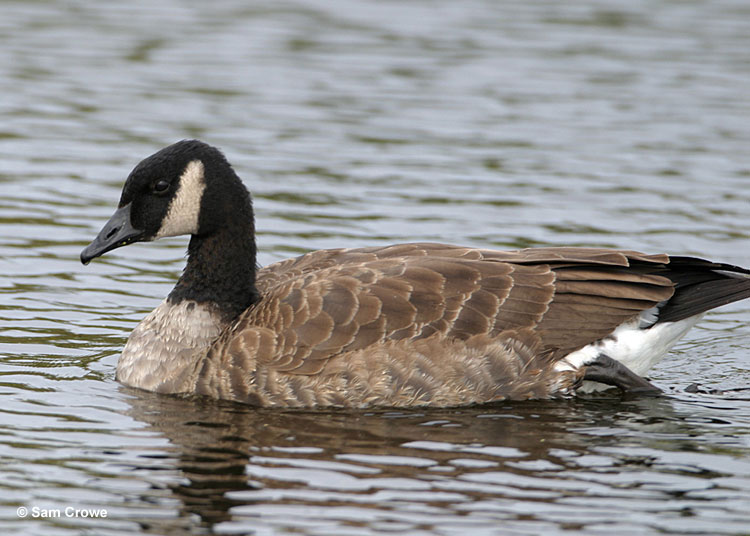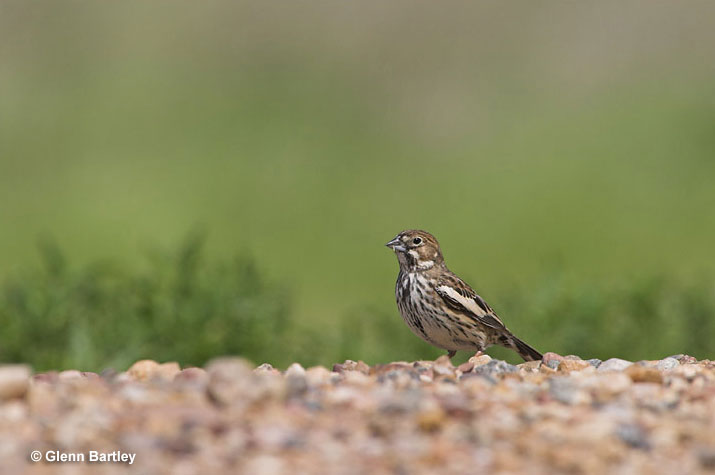
Colorado is a rugged, western state with 104,094 square miles of grasslands, montane habitats, and wetlands. For bird lovers, the beautiful scenery might only be surpassed by the many birds of Colorado!
In total, 519 species have been found in Colorado, a total that places The Centennial State among the top ten states with the highest number of bird species.
Warm summers, cool winters, and cold weather in the mountains always make for exciting birding in Colorado. Although habitat loss has caused some local declines of a few species, overall, it’s pretty easy to see dozens of birds in this gorgeous state.
Have you birded in Colorado? There’s a lot to look at!
This up-to-date list of common backyard and wild birds in Colorado will help
On this page
- Most Common Birds of Colorado
- House Finch
- American Robin
- Northern Flicker
- Black-capped Chickadee
- Canada Goose
- Mallard
- Black-billed Magpie
- Dark-eyed Junco
- Red-winged Blackbird
- American Crow
- Blue Jay
- European Starling
- Red-tailed Hawk
- Eurasian Collared-Dove
- Mourning Dove
- Song Sparrow
- American Goldfinch
- White-breasted Nuthatch
- Spotted Towhee
- Common Raven
- Downy Woodpecker
- House Sparrow
- Ring-billed Gull
- White-crowned Sparrow
- Mountain Chickadee
- Great Blue Heron
- Broad-tailed Hummingbird
- Western Meadowlark
- Killdeer
- Gadwall
- Barn Swallow
- House Wren
- Rock Pigeon
- Common Grackle
- Double-crested Cormorant
- Frequently Asked Questions
Most Common Birds of Colorado
Colorado has hundreds of birds and many are common! To make the best, up-to-date list of the most commonly seen birds in the state, we used data from eBird to arrange a list of bird species from the most common to the least common.
To help with identification, we also included accurate information about field marks and behavior.
PS! Remember that birds at the bottom of this list are common birds too!
House Finch
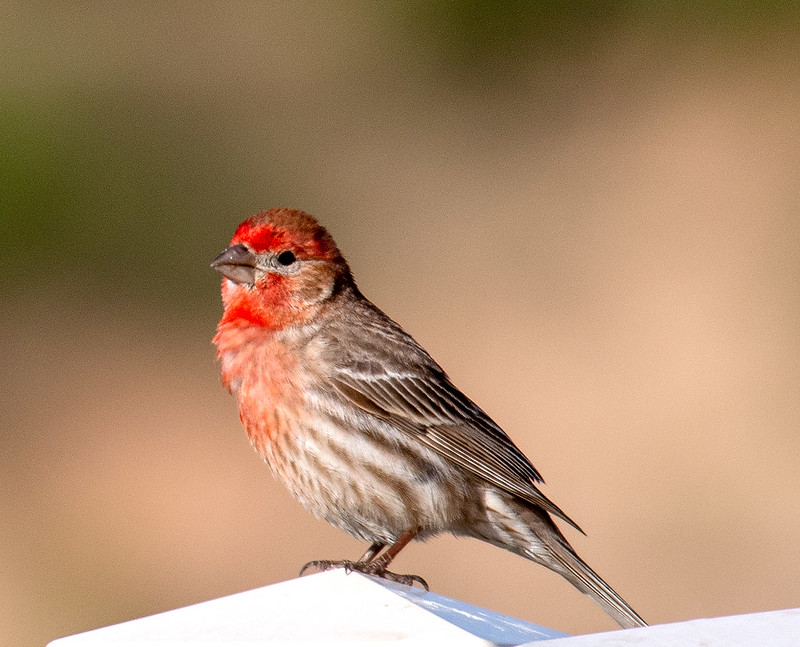
Photograph © John Hansen
Scientific name: Haemorhous mexicanus
Length: 6 inches
Weight: .88 ounces
Wingspan: 10 inches
Song: “chip,chip,chiprididip,ZREEYachip”
House Finches are sparrow-sized birds with dark, rounded beaks and fairly long wings. Males are orange-red or rose-red on their head, throat and breast, and have some red on their rump. They also have brownish streaks on their back, flanks, and white belly.
Like the male, female House Finches have two white wing bars on long, gray-brown wings. However, they lack red and are mostly streaked, dull brown-gray birds.
House Finches feed on seeds, buds, fruit, and flowers. They often visit feeders in Colorado but also forage on the ground and in bushes and trees.
We see these pretty birds in deserts and arid zones, and in parks, farmland, urban areas, and other semi-open habitats.
The House Finch makes a soft cup nest built on a tree, building ledge or other spot with some overhanging cover. They often occur in small groups and live in southern Canada, most of the USA (including Colorado), and Mexico.
Key Identifications:
- Reddish or plain gray-brown, streaked, sparrow-like bird.
- Eats seeds, flowers, buds, and fruit. Can visit feeders but also forages on the ground and in bushes and trees.
- Makes a soft cup nest in trees, on building ledges, and other places.
- The House Finch often makes a soft, “fidip” call. Males also sing a warbling song from prominent, high perches. It sounds like, “chip,chip,chiprididip,ZREEYachip”.
House Finches are sparrow-like, reddish or brownish, streaked birds. They live in arid zones as well as in parks and urban areas. All of the millions of House Finches that live east of the Rocky Mountains are descendants of birds released on Long Island in 1939.
American Robin
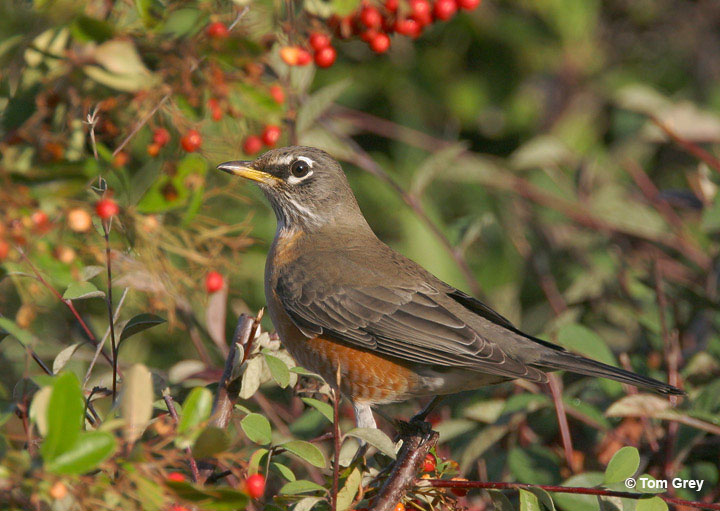
Photograph © Tom Grey
Scientific name: Turdus migratorius
Length: 10 inches
Weight: 2.7 ounces
Wingspan: 17 inches
Song: “cheery, cheery, cheery, cheery, cheer, cheer”
The American Robin is a familiar and common thrush that is dark gray above and brick red below. It also has an orange-yellow bill, a blackish head with white markings around the eyes and on the throat, and a white belly.
Both sexes of this thrush species are similar but males are darker above and more reddish on the underparts. Young American Robins have more white marks on their faces and spotting on orange underparts.
In flight, this common thrush in Colorado also shows white corners in its outer tail feathers.
American Robins forage on the ground for worms, insects, snails, and other small creatures. In winter, these common birds flock together and perch in trees and bushes to eat berries and fruit.
The American Robin makes a cup nest in trees and lives in parks, woodlands, towns, and many other habitats. They reside in Alaska, most of Canada, the USA, and in Mexico.
Key Identifications:
- Fair-sized songbird that is dark gray above, and brick red and white below.
- Forages for worms and bugs on lawns and other open grassy areas, also flocks together to feed on fruiting trees in the winter.
- Makes a cup nest in trees.
- The American Robin is quite vocal and makes a loud, sharp, “yenk!” call and quieter “check,check,check” calls. It also has a lovely cheerful song of caroled phrases, “cheery, cheery, cheery, cheery, cheer, cheer”.
The American Robin is a common, handsome thrush with dark gray upperparts and brick red and white underparts. It forages for worms and bugs on lawns and other open, grassy spots, and also eats berries. Populations of the American Robin have been estimated at 370,000,000, making it the most numerous landbird in North America.
Northern Flicker
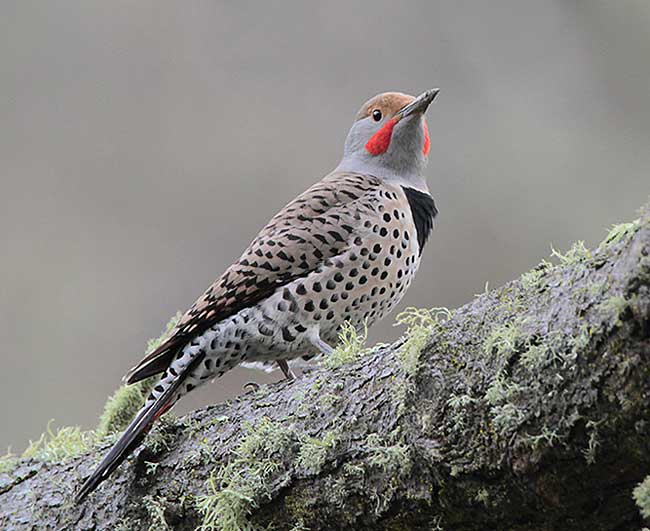
Scientific name: Colaptes auratus
Length: 12.5 inches
Weight: 4.6 ounces
Wingspan: 20 inches
Song: “kick,kick,kik,kik,kik.kik.kik.kik.kik.kik.kik.kik!”
Northern Flickers are fairly large, tan and gray woodpeckers with barring on their backs. They have a black mark on their breast, black spotting below, and a dark, stout beak.
Males in the east have a tawny throat and face with a black mustache and small red spot on the back of their heads. Males in the west have mostly gray heads with a red mustache.
Female Northern Flickers look like males but lack the mustache mark.
In bounding flight, they have white rumps and flash color on their underwings. This is bright yellow in eastern birds and reddish in flickers west of the Rocky Mountains.
This woodpecker eats many ants and other insects that it catches on the ground. It forages by flying to the ground, locating anthills, and lapping them up with its long tongue.
Northern Flickers nest in tree cavities and live in wooded and open habitats in Canada, the USA, and Mexico.
Key Identifications:
- Tan and gray woodpecker with black barring above, black marks below, and a bright, white rump.
- Forages for ants and other insects on the ground.
- Nests in tree cavities.
- A vocal woodpecker, the Northern Flicker often gives loud, “flicka,flicka,flicka” calls, and another loud, single note that sounds like, “Keer!” They also have a long, laughing vocalization of repeated notes, “kick,kick,kik,kik,kik.kik.kik.kik.kik.kik.kik.kik!”.
Northern Flickers are fairly big, tan woodpeckers with gray highlights, a white rump, and black markings. They mostly forage for ants on the ground in open and wooded areas. The red-shafted Northern Flickers in the west used to be considered a separate species from the yellow-shafted flickers of the east. At present, they are considered to be one species because they frequently hybridize with each other.
Black-capped Chickadee
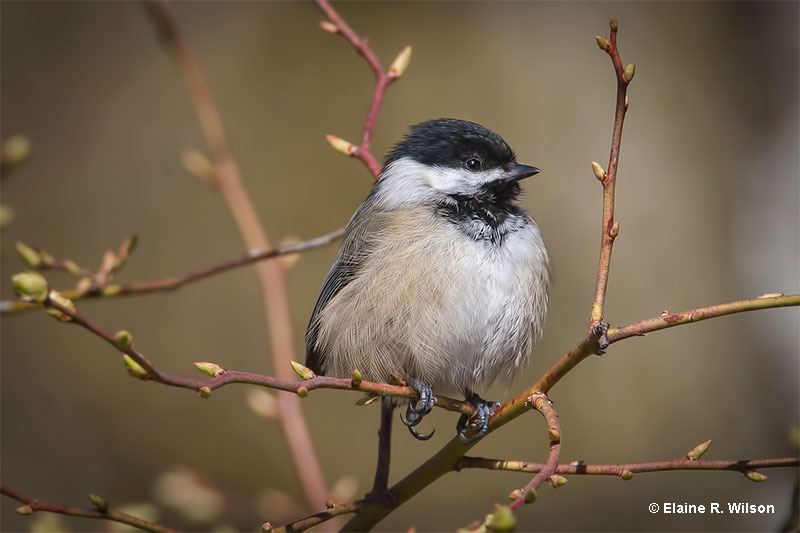
Scientific name: Poecile atricapilla
Length: 5.25 inches
Weight: .39 ounces
Wingspan: 8 inches
Song: “see bee, see bee”
Black-capped Chickadees are small grayish birds with a black cap, black throat, and a stubby black beak. Both sexes look alike and have a white face, white edging to the feathers in their wings, and some buff on their underparts.
These cute little birds feed on caterpillars, insects, spiders, seeds, and fruit. They are regular visitors to feeders but also forage on bark, twigs, and in foliage. When foraging, they often hang upside down from twigs and usually occur in small flocks.
This species makes a small, soft nest out of moss and deer hair. It builds its nest in tree cavities and can also use nest boxes.
Black-capped Chickadees live in a variety of wooded habitats and can also occur in gardens. They are year-round residents in parts of Alaska, Canada, and the northern USA south to Oregon, northern New Mexico, northern Ohio, and the Appalachian Mountains to North Carolina.
Key Identifications:
- Small, cute, grayish birds with a black cap, white face, and a black throat.
- Forages for insects, spiders, seeds, and fruit in wooded habitats. Also visits feeders.
- Nests in tree cavities and nest boxes.
- This little bird is quite vocal and often says its name, “chick-a-deedeedeedeedee”. They also make other chattering calls and sing a whistled song, “see bee, see bee”.
The Black-capped Chickadee is a small, acrobatic bird with a black cap, white face, and a black throat. It is also a state bird of Massachusetts. They usually forage in flocks with other chickadees and other small birds, and often visit feeders. This species hides dozens of seeds and other bits of food for the winter, and recalls where each of these food items are hidden.
Canada Goose
Scientific name: Branta canadensis
Length: 29.9 to 43.3 inches
Weight: 105.8 to 317.5 ounces
Wingspan: 50 to 66.9 inches
Song: Canada Geese don’t have a song, but they do produce a variety of calls, including loud honks, hisses, cackles, and barks.
Canada Geese have white cheeks, black heads, white chinstraps, black necks, brown backs, and tan breasts.
Canada Geese live in many different habitats near grain fields, grassy fields, and water.
These waterbirds are particularly drawn to lawns because when they’re caring for their young, manicured lawns give them an unobstructed, broad view of any approaching predators, and they can digest grass.
In the spring and summer months, geese concentrate on consuming sedges and grasses, including eelgrass and skunk cabbage leaves. During the fall and winter months, they rely more on seeds and berries, including berries and agricultural grains.
Key Identifications:
- Look for their white cheeks, white chinstraps, black heads, black necks, brown backs, and tan breasts.
- Male and Female Canadian Geese look identical. The best ways to differentiate the two is by looking at size and behavior.
- Canada Geese are larger than a Mallard.
- Canada Geese are large waterbirds. They have long necks, large bodies, wide, flat bills, and big webbed feet.
Thousands of Canada Geese migrate south and north every year. They’re easily recognizable with their long V-shaped formations. However, more and more of these birds are staying put in suburban and urban areas year-round, due to lawn maintenance.
Mallard
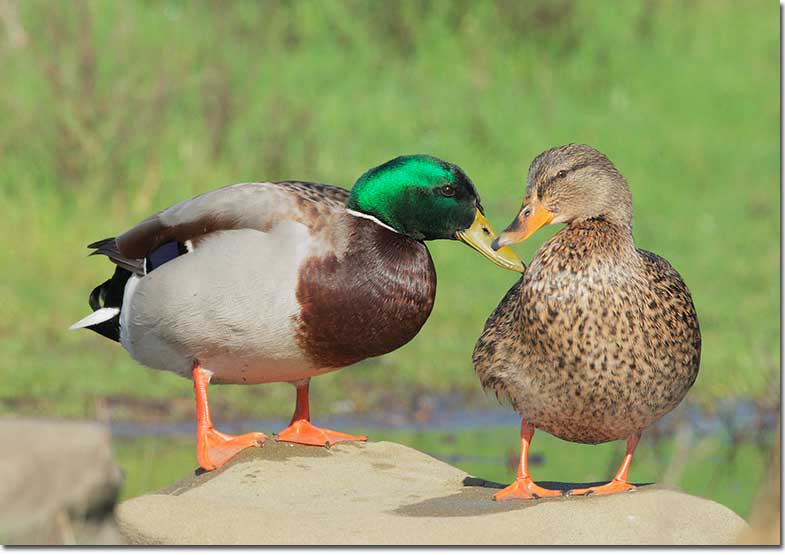
Mallard pair (Male and female)
Scientific name: Anas platyrhynchos
Length: 23 inches
Weight: 2.4 pounds
Wingspan: 35 inches
Song: “quack, quack”
The Mallard is a fairly large, familiar duck. The male has a metallic green head, yellow bill, narrow white ring around the neck, and chestnut breast. The rest of the bird is pale gray with pale brown, and black on its back and around his tail.
Female Mallards are mottled brown and buff with a dark crown and line through the eyes, and have a dark gray and orange beak.
In flight, both sexes show a green-blue wing patch bordered with white.
Mallards eat a variety of items, including insect larvae, snails, other small aquatic creatures, acorns, seeds, and grain. They forage by filtering and picking up food items in and near shallow water, and in farm fields.
This duck species makes a shallow nest with sticks and lined with down feathers. It builds its nest on the ground, hidden in grass or under a bush.
The Mallard lives in ponds, marshes, and many wetland habitats in Canada, USA, and Eurasia.
Key Identifications:
- Large and familiar duck, male has dark green head, white ring around the neck, and a chestnut breast. Female is mottled buff and brown, and has a dark gray and orange beak.
- Feeds on insect larvae, grain, seeds, and other items picked up with its bill in and near shallow water.
- Makes a shallow stick nest hidden in grass or under a bush.
- The female Mallard makes the classic “quack, quack” duck sound. Males make similar but softer sounds and a whistling call.
The Mallard is a fairly large and familiar duck with a dark green head (the male), or is buff and brown with a dark gray and orange beak (the female). Thus duck species often lives near people and occurs on lakes, ponds, and other wetlands. No matter how different they look, most small domestic duck species are descended from wild Mallards.
See more: Common duck species in Colorado
Black-billed Magpie
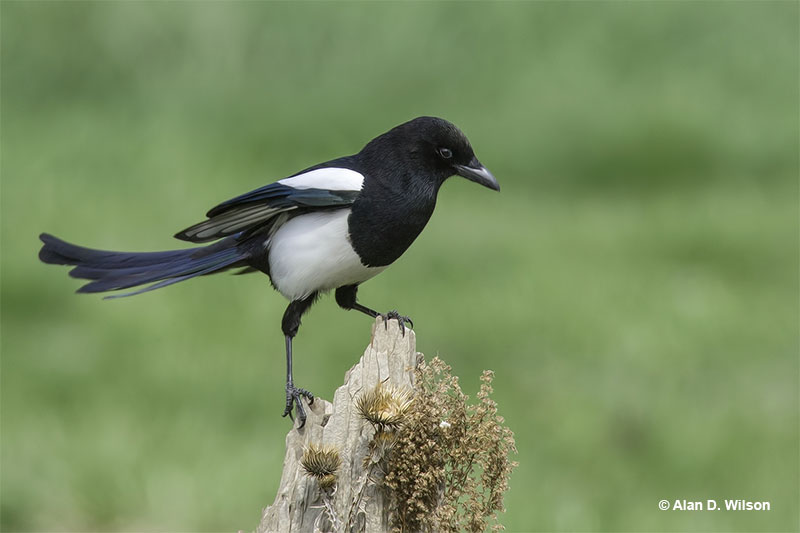
Scientific name: Pica hudsonia
Length: 19 inches
Weight: 6 ounces
Wingspan: 25 inches
Song: “reh reh reh reh reh!”
The Black-billed Magpie is a big, bold, black and white bird with a long tail. This relative of crows and jays has a stout, crow-like beak and glossy green and purple in its wings and tail.
Males and females look alike and also show bold white wing patches in flight. These birds fly with a few flaps followed by short brief glides and usually occur in groups.
They are omnivorous and eat a wide variety of food items. In winter, magpies often scavenge animals killed by predators as well as roadkill. They and also eat insects, small animals, seeds, and other items.
Black-billed Magpies make domed nests out of sticks and mud, and build them in trees and on poles and other structures.
This species lives in a variety of open, semi-open, and wooded habitats in Alaska, western and central Canada, and much of the western USA south to New Mexico.
Key Identifications:
- Medium to large black and white bird with a black beak, and a long, glossy green and purple tail.
- Feeds on carrion, small animals, seeds, and other food scraps.
- Makes a domed nest out of mud and sticks.
- This vocal bird makes a repeated raspy vocalization, “reh reh reh reh reh!”.
The Black-billed Magpie is a bold black and white bird with a long tail. They often occur in groups that forage on carrion, small animals, and other food scraps. This species often perches on cows, Moose, and other large herbivores to eat the ticks that attach to these large animals.
Dark-eyed Junco
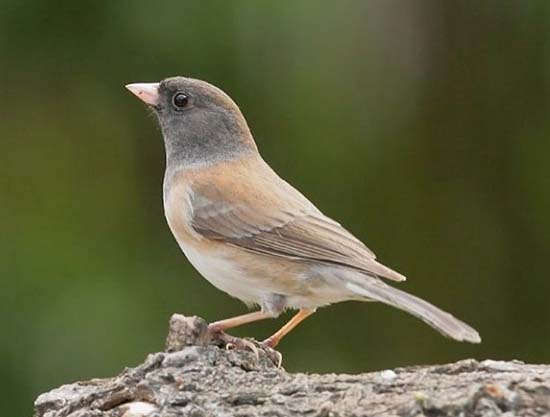
Scientific name: Junco hyemalis
Length: 6.25 inches
Weight: .67 ounces
Wingspan: 9.25 inches
Song: “sipsipsipsipsipsipsip”
Dark-eyed Juncos are sparrow-like birds with pale conical bills and dark eyes. This small bird has variable plumage with most being slate gray or gray and brown with white on their bellies, and white under their tails.
Other plumages include birds with dark masks and faint white wing bars, juncos with pale gray hoods and pinkish sides, and birds with blackish hoods and chestnut sides.
In flight, all Dark-eyed Juncos show extensive white in their longish tails.
This species feeds on seeds, insects, and some fruit and grain. Juncos forage on the ground in wooded areas, parks, and other habitats. They also feed on fallen seed beneath feeders.
They build cup nests on the ground under fallen logs, in roots, and other hidden spots. After breeding, juncos form flocks that forage together in similar wooded and semi-open habitats.
Dark-eyed Juncos are common birds in Canada, the USA, and parts of Mexico.
Key Identifications:
- Sparrow-like gray and brown bird with dark eyes, a pale beak, and white in the tail.
- Forages for seeds and insects on the ground, can feed on seeds at and beneath feeders.
- Builds a cup-shaped nest on the ground in tree roots, under logs, and other hidden places.
- This species often makes a sharp, high-pitched chip note, “pik!”. On breeding grounds, males sing a short, plain trill, “sipsipsipsipsipsipsip”.
Dark-eyed Juncos are sparrow-like, gray and brown birds with much white in the tail. Common wintering birds in many areas, they forage for seeds on the ground in wooded and park-like habitats. In many places, this common species is also known the “Snowbird” on account of only occurring in the winter months and having white on the belly and tail.
Red-winged Blackbird
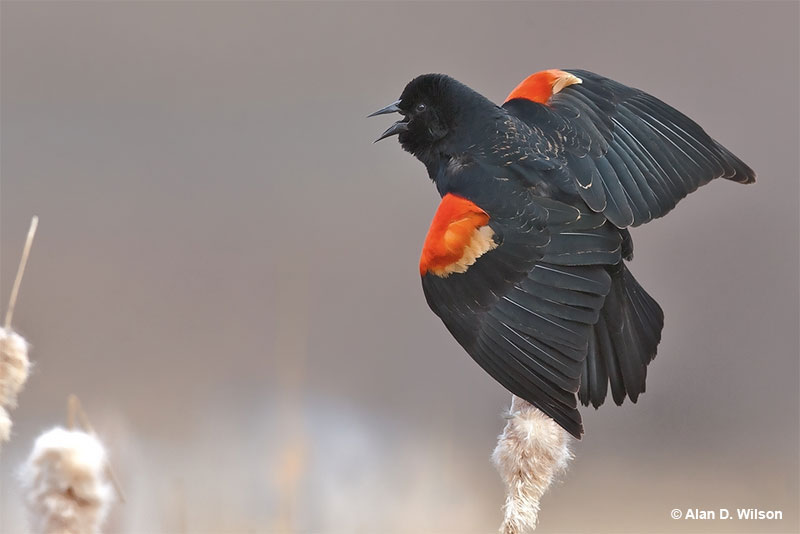
Scientific name: Agelaius phoeniceus
Length: 8.75 inches
Weight: 1.8 ounces
Wingspan: 13 inches
Song: “kan-keree!”
The Red-winged Blackbird is a medium-sized blackbird species with a sharp, all black bill. Males also have a scarlet patch with a pale yellow border on the shoulder of each wing.
Female Red-winged Blackbirds are dark, heavily streaked, brownish-gray birds with an orange-buff eyebrow and throat. She can also have a little bit of dingy red on her shoulder.
Red-winged Blackbirds often flock together and can form very large groups in the winter. They feed on seeds, grain, and insects found on lawns, in marshes, farm fields, and other open habitats.
This species builds a cup nest made of leaves and dead stems in a bush or other low vegetation in a marsh, park, or brushy field.
Red-winged Blackbirds are very common birds that live in all sorts of open habitats. We see them in parks, farming areas, and marshes in much of Canada, the USA, Mexico, and parts of the Central America.
Key Identifications:
- Males are medium-sized blackbirds with a bright red patch on their wings. Females are heavily streaked, have a sharp black beak, and buff on the head.
- Feeds on seeds, grain, and insects on the ground in many open habitats.
- Builds a cup nest in a bush or other low vegetation.
- Red-winged Blackbirds often call. Males sing a loud, “kan-keree!” and both sexes also make “check!” calls and a high-pitched whistle-like sound.
The Red-winged Blackbird is a common, social species easily seen in marshes and open habitats. In the winter, it can form huge flocks that feed in farm fields. This species can make a daily commute of 50 miles to and from roosting and feeding sites.
American Crow

Scientific name: Corvus brachyrhynchos
Length: 17.5 inches
Weight: 1 pound
Wingspan: 39 inches
Song: “Caw! Caw!”
The American Crow is a big, all black bird with a strong, stout bill. In certain lighting, it can have metallic purple and blue iridescence.
Both sexes look the same and have some feathering on their beaks, long, broad wings, and a broad tail.
American Crows have direct flight with strong, steady wing beats. Crows are very social and intelligent birds that are usually seen in flocks. They forage together on the ground or in trees and eat just about anything they can find.
Some of their more regular foods include carrion, fruit, nuts, seeds, insects, and small animals. Like most jays and crow species, they also eat the eggs and nestlings of other bird species.
This species builds bulky stick nests high in trees and lives in most habitats except for high mountains and arid zones.
The American Crow occurs in southern Alaska and much of Canada and the USA.
Key Identifications:
- Big, all black bird with long, broad wing and a broad tail.
- Forages for carrion, fruit, seeds, insects, and small animals.
- Builds a bulky stick nest high in a tree.
- American Crows are very vocal birds. They can make several calls but their most common one is, “Caw! Caw! Caw!”.
The American Crow is a common, large black bird that frequently calls, “Caw! Caw! Caw!”. It usually occurs in flocks and lives in all sorts of places, even urban zones. These birds are very smart and have funerals or wakes! When a crow dies, other crows mark the occasion by gathering together and loudly calling.
Blue Jay
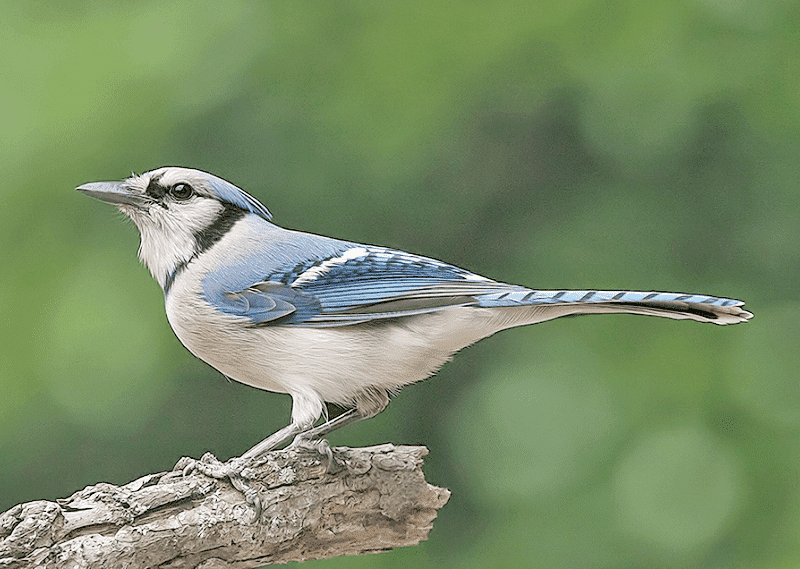
Photograph © Alan Wilson.
Scientific name: Cyanocitta cristata
Length: 11 inches
Weight: 3 ounces
Wingspan: 16 inches
Song: “Nyeah! Nyeah! Nyeah!”
The Blue Jay is a fairly large, crested bird with a straight black bill. Both sexes look alike and are blue above and gray and white below. They also have some small black lines on their faces and a narrow black necklace that goes up to the side of their face and crest.
Blue Jays also have some white markings and black barring in their wings and on their tail. Young birds look like adults but are duller blue.
They make messy cup nests at various heights in a variety of trees.
These social and intelligent birds feed on acorns, nuts, insects, and other small creatures. Like other members of the jay and crow family, they eat the eggs and nestlings of other birds.
The Blue Jay is a common bird of woodlands, forest, and towns east of the Rocky Mountains in the USA and central and southern Canada.
Key Identifications:
- Crested, fairly large bird with bright blue above and gray below.
- Feeds in trees and at feeders. Eats acorns, nuts, insects and many other food items.
- Makes a messy cup nest of sticks in a tree.
- Very vocal. In flight, Blue Jays often call as they swoop through the trees. They make a variety of sounds and mimic some other birds. Common calls include a nasal and complaining “Nyeah! Nyeah! Nyeah!” and various whistled calls.
The Blue Jay is a common, intelligent, and noisy bird. They make their presence known with their loud calls and can visit feeders. Ironically, when communicating with each other at close quarters, this species makes much softer and quieter calls. It’s almost as if they are talking with each other!
European Starling
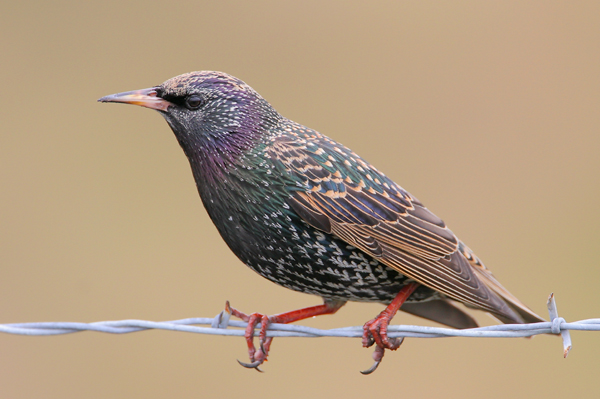
Photograph © Greg Lavaty.
Scientific name: Sturnus vulgaris
Length: 8.5 inches
Weight: 2.9 ounces
Wingspan: 16 inches
Song: “tiktiktitZHREEree..tiktiktik..ZHREE”
European Starlings are plump, short-tailed birds with long sharp beaks and longish, pointed wings. In summer, they have yellow beaks, glossy black plumage with purple and green highlights, and some small white spots.
Males and females are similar but males have less spotting and glossier plumage. In winter, they have black beaks, white spots, and more reddish colors in their wings. Young starlings are shaped like adults but are grayish-brown in color.
This species feeds on a variety of insects, fruit, and seeds. They can dominate bird feeders and are common species in urban areas, parks, farmlands, and other open habitats.
This European Starling builds a soft cup nest in a tree cavity, nest box, or suitable cavity in other structures.
European Starlings flock with each other and blackbird species, especially during the winter. They live across a large part of Canada and the USA, and are common birds in Colorado.
Key Identifications:
- Rotund, short-tailed bird with a long, sharp beak, and pointed wings. Glossy black with some spotting in the summer and blackish with heavy white spotting and streaking in the winter.
- Feeds on seeds, fruit, and insects. Visits feeders and forages on the ground in flocks.
- Builds a soft cup nest in nest boxes and other cavities.
- The European Starling makes a wide variety of mechanical and whistled sounds. They also mimic other birds and sounds in their environment. They sing long, jumbled mechanical-sounding songs, “tiktiktitZHREEree..tiktiktik..ZHREE”.
European Starlings are rounded, blackish birds with long, sharp beaks and short tails. They live in towns, cities, parks, on farms, and in other open habitats. This species forms large flocks called, “murmurations” that move in coordinated patterns.
Red-tailed Hawk
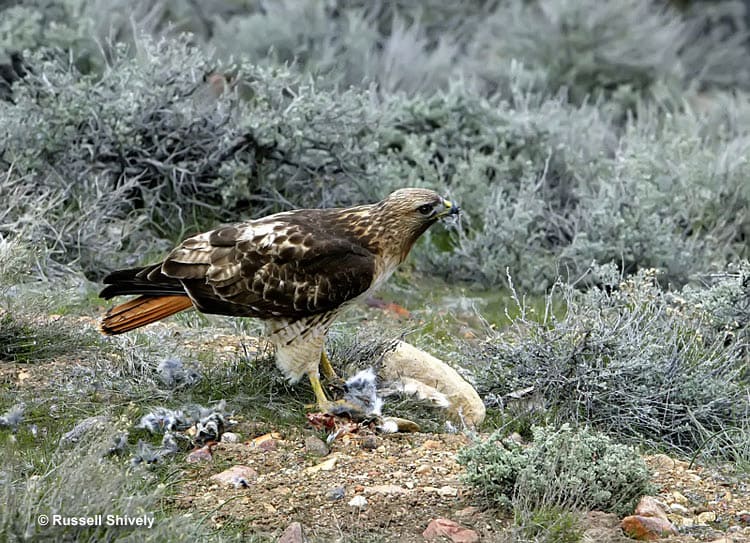
Scientific name: Buteo jamaicensis
Length: 19 inches
Weight: 2.4 pounds
Wingspan: 49 inches
Song: “kreeeyeah!”
The Red-tailed Hawk is a big, bulky raptor with a broad, reddish tail. Adults have dark brown upperparts and can have dark brown, buff, or pale underparts with a dark “belly band”.
Both sexes look the same, but females are larger. Juvenile Red-tailed Hawks have dark barring on a brown tail.
In flight, this species often soars high overhead on long, broad wings. A square, pale patch is often visible on the base of the primaries.
Red-tailed Hawks feed on small animals such as squirrels, rabbits, snakes, and various other animals. They catch their prey by watching for food from a perch or soaring overhead and then swooping down on the animal.
See more: Most Common Hawks in Colorado
This raptor builds a big stick nest high in a tree. They are one of the most common birds of Colorado.
In many parts of its range, the Red-tailed Hawk is the most common raptor. It lives in Alaska, Canada and the USA south to the Caribbean and Central America.
Key Identifications:
- Large and hefty raptor with a broad reddish tail.
- Catches squirrels and other small animals by swooping down onto them from a perch or soaring flight.
- Builds bulky stick nest in trees.
- Often calls in flight, the classic Hollywood hawk sound, “kreeeyeah!”
Red-tailed Hawks are big, bulky raptors with reddish tails. They usually occur alone and are often seen perched on roadside trees and telephone poles. The amazing eyesight of the Red-tailed Hawk is eight times better than a person’s eyesight.
Eurasian Collared-Dove
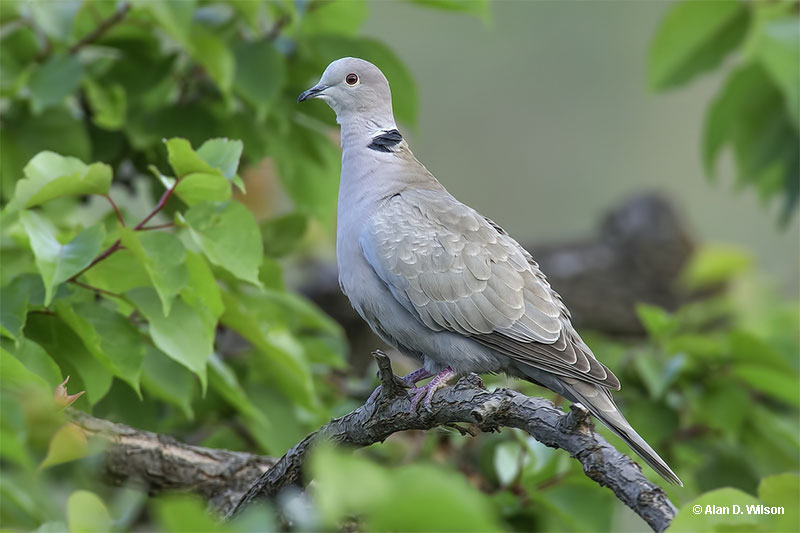
© Alan D. Wilson
Scientific name: Streptopelia decaocto
Length: 13 inches
Weight: 7 ounces
Wingspan: 22 inches
Song: “hoo hoo hoowuh hoo WUH hoowuh hoo WUH!”
The Eurasian Collared-Dove is a medium to large, pale tan and gray dove with a black mark on its nape. Males and females look similar, have a slender black beak, and a narrow gray eyering.
Eurasian Collared-Doves have black primaries and white in their tail feathers. These field marks are especially visible in flight.
These doves feed on grain and seeds picked from the ground and they can also visit feeders. In some places, Eurasian Collared-Doves occur in large flocks, especially around farms and grain silos.
The Eurasian Collared-Dove makes messy stick nests in trees and on structures near people. This species is highly adapted to living with and near people and prefers to feed in farm fields, gardens, towns, and other places where they can find grain and seeds.
This Eurasian species was accidentally introduced to North America in the 1970s and 1980s. It now occurs in parts of Alaska and much of Canada and the USA.
Key Identifications:
- Fairly large, pale tan and gray dove with black primaries and white in its longish tail.
- Forages for grain and seeds on the ground.
- Makes messy stick nests in gardens, parks, and on farms.
- This dove species often calls and makes a typical dove-like sound, “hoo hoo hoowuh hoo WUH hoowuh hoo WUH!”.
The Eurasian Collared-Dove is a fair-sized pale tan and gray dove with much white in its longish tail. These birds can probably only survive near people and live in gardens, towns, and on farms. When drinking water, this species uses its beak like a straw.
Mourning Dove
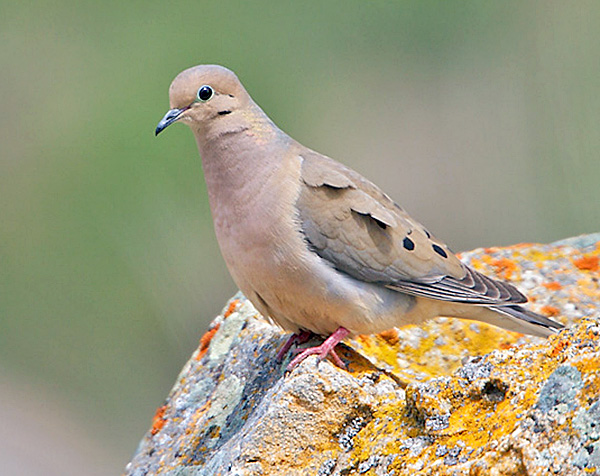
Photograph © Greg Lavaty.
Scientific name: Zenaida macroura
Length: 12 inches
Weight: 4.2 ounces
Wingspan: 18 inches
Song: “hooOOA, hoo, hoo, hoo”
Mourning Doves are medium-sized, grayish-brown doves with long tails. They have small black spots on their wings and a small head with a slender, dark beak.
Males and females also have narrow gray eyerings, a black mark on the face, and pale iridescent gold on the sides of their necks. They look alike except for males having more gray on the head and neck, and more iridescence.
This dove has fairly long wings and swift, direct flight. When flying, it shows black and white in its tail.
The Mourning Dove occurs in woodlands, gardens, on farms, and in urban areas. This common feeder visitor eats seeds and grains. It also forages in open situations, picking food from the ground.
This pleasant dove species can visit a feeder on its own or forage in small flocks. It builds an unkempt stick nest in bushes and trees and is very common throughout the USA, southern Canada, and Mexico.
Key Identifications:
- Plain brown and gray dove with a long, pointed tail.
- Feeds on seeds at feeders and on the ground in open areas.
- Makes a small, messy nest of sticks in trees.
- Sings a sad and owl-like “hooOOA, hoo, hoo, hoo”.
The Mourning Dove is the common garden dove in most of its range. It often visits feeders and its cooing song is commonly mistaken for an owl. This species has a short lifespan with many adults only living for a couple of years or less.
Song Sparrow
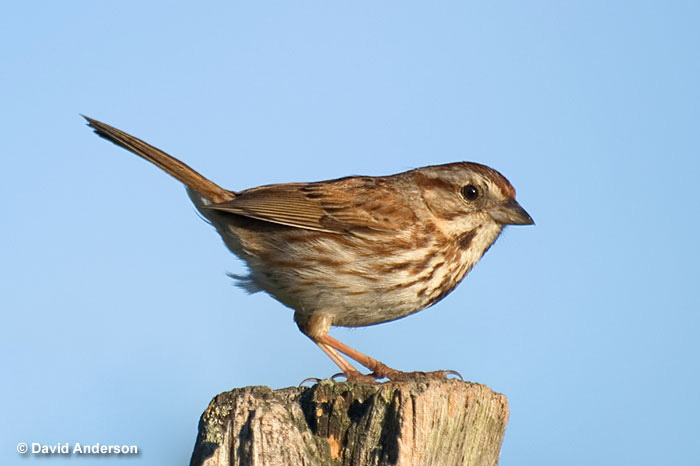
Scientific name: Melospiza melodia
Length: 4.7 to 6.7 inches
Weight: 0.4 to 1.9 ounces
Wingspan: 7.1 to 9.4 inches
Song: 2 to 6 phrases that usually start with well-spaced, abrupt notes and finishes with a trill or buzz.
Song Sparrows are streaky brown overall and have thick streaks on their flanks and white chest. When taking a closer look at these birds, we can see that their heads are an attractive mix of slaty gray and warm red-brown. It’s important to note that these shades, as well as the amount of streaking, can vary significantly across their range in North America.
Song Sparrows are found in a wide range of open habitats, including suburbs, tidal marshes, forest edges, arctic grasslands, lake edges, desert scrub, chaparral, and aspen parklands.
During the summer, Song Sparrows consume a lot of different insects and other invertebrates. Year-round they consume fruits and seeds. Some of the prey they consume include grasshoppers, weevils, caterpillars, craneflies, earthworms, and spiders.
Key Identifications:
- Song Sparrows are streaky brown overall and have thick streaks on their flanks and white chest.
- Their color and amount of streaking can vary significantly in Colorado and across their range in North America.
- These birds are slightly larger than a Chipping Sparrow.
- These sparrows are fairly bulky. They have short, stout bills, somewhat rounded heads, broad wings, and long, rounded tails.
Song Sparrows are one the most familiar sparrows in North America. However, there are 24 recognized subspecies of Song Sparrows.
American Goldfinch

Scientific name: Spinus tristis
Length: 4.3 to 5.1 inches
Weight: 0.4 to 0.7 ounces
Wingspan: 7.5 to 8.7 inches
Song: “po-ta-to-chip”
Adult male Eastern Goldfinches have black foreheads, black wings with white markings, white patches both above and below the tail, and are bright yellow overall in the spring and early summer. Adult female Eastern Goldfinches are paler yellow underneath and olive above. In the winter, both males and females are unstreaked brown, drab, and have blackish wings with two faint wing bars.
American Goldfinches inhabit overgrown areas like open floodplains and weedy fields, especially thistle, aster, and sunflower plants. They feed off of these plants and use trees and shrubs for nesting. It’s not uncommon to see these birds in backyards, parks, and suburbs as well.
Eastern Goldfinches primarily consume seeds; it’s rare to see them consume anything else. The main types of seeds they eat include thistle, sunflower, grass seeds, and asters.
Key Identifications:
- Male birds have black foreheads, black wings with white markings, white patches both above and below the tail, and are bright yellow overall in the spring and early summer.
- Male and Female American Goldfinch look similar. Females are paler yellow underneath and olive above. Both males and females look the same in the winter.
- These birds are smaller than Tufted Titmice.
- The Eastern Goldfinch is a small species of finch. They have short, notched tails, short, conical bills, long wings, and a small head.
Eastern Goldfinches are very acrobatic and active birds. You can commonly see them balancing on thistle seedheads, dandelions, and other plants to pick seeds. Eastern Goldfinches are known to visit bird feeders as long as you offer the right seeds. To encourage these finches to visit your yard, it’s highly recommended that you plant native composite plants like thistles and milkweed.
White-breasted Nuthatch
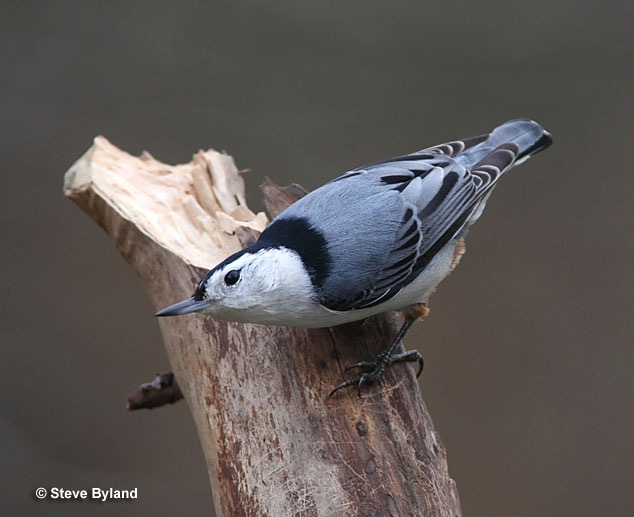
Scientific name: Sitta carolinensis
Length: 5.1 to 5.5 inches
Weight: 0.6 to 1.1 ounces
Wingspan: 7.9 to 10.6 inches
Song: “wha-wha-wha”
White-breasted Nuthatches have frosty white underparts and faces as well as gray-blue backs. Additionally, under the tail and the lower belly are chestnut brown, and the cap and neck are either black or gray.
White-breasted Nuthatches inhabit mature woods and are most commonly found in coniferous and deciduous forests. You can also find them in open areas with large trees and at woodland edges.
Nuthatches primarily consume insects. Some of the prey they consume include tree hoppers, beetles, weevil larvae, ants, wood-boring beetle larvae, and caterpillars. They also eat nuts and seeds like sunflower seeds and acorns.
Key Identifications:
- White-breasted Nuthatches are smaller than a Tufted Titmouse.
- White-breasted Nuthatches have frosty white underparts and faces and gray-blue backs.
- These birds have large heads, almost no necks, narrow, straight bills, and very short tails.
- White-breasted Nuthatches can be easily identified by their habit of sneaking up and down tree trunks.
White-breasted Nuthatches are widespread, agile little birds. They visit bird feeders and will readily consume mealworms and meaty, large seeds. White-breasted Nuthatches are known as the “upside down” bird. This is because it’s not uncommon to see them creeping headfirst down the trunk of a tree in search of insects.
Spotted Towhee
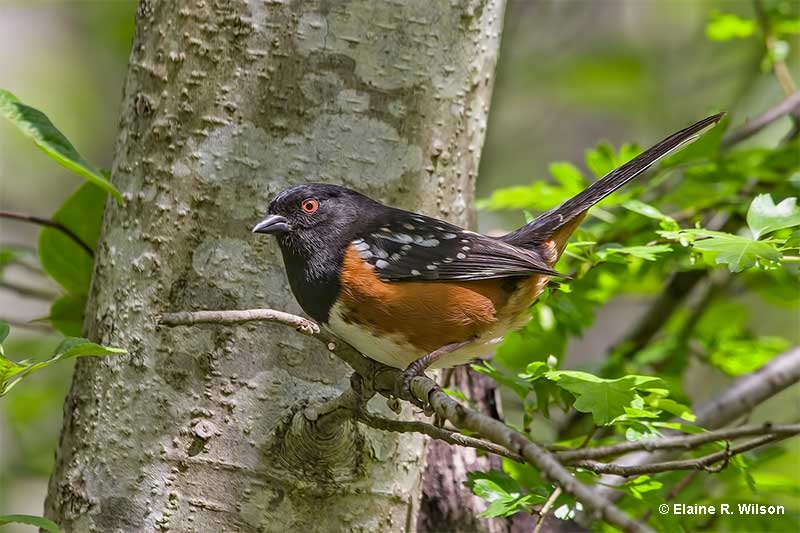
© Elaine R. Wilson
Scientific name: Pipilo maculatus
Length: 8.5 inches
Weight: 1.4 ounces
Wingspan: 10.5 inches
Song: “two two two chreee!”
The Spotted Towhee is a thrush-sized, colorful, sparrow-like bird with reddish eyes and a black, finch-like beak. It has black upperparts with some small white spots, a black hood, and a white belly with chestnut flanks.
It also has a buff undertail, and white spots on the underside of its longish, rounded tail. Both sexes look similar, but the female has a grayish-brown head. Juveniles are like dark brown, streaked sparrows with white in their tails, two buff wing bars, and a buff undertail.
Spotted Towhees find insects and seeds by using both feet to scratch and toss leaf litter. This bird also eats berries in bushes, especially in winter.
This species makes an open cup nest out of grass and other plant matter in dense vegetation near or on the ground.
The Spotted Towhee lives in shrubby habitats from Manitoba and the Dakotas west to the coast. Spotted Towhees are some of the most common birds of Colorado. In winter they range east to Kansas and south to Texas.
Key Identifications:
- Medium-sized, colorful songbird with a black hood, white spotting on black upperparts, and chestnut flanks.
- Forages on the ground for insects and seeds in leaf litter in shrubby habitats.
- Makes an open cup nest in dense vegetation, on or near the ground.
- Often calls and makes a nasal, cat-like call, “rheyeah”, and sings a short trilled song, “two two two chreee!”
Spotted Towhees are thrush-sized black and white birds with chestnut flanks and white spotting on their wings and/or back. They occur in pairs that forage for insects and seeds in leaf litter. When female Spotted Towhees are disturbed on their nests, instead of flying away, they distract predators by running away.
Common Raven
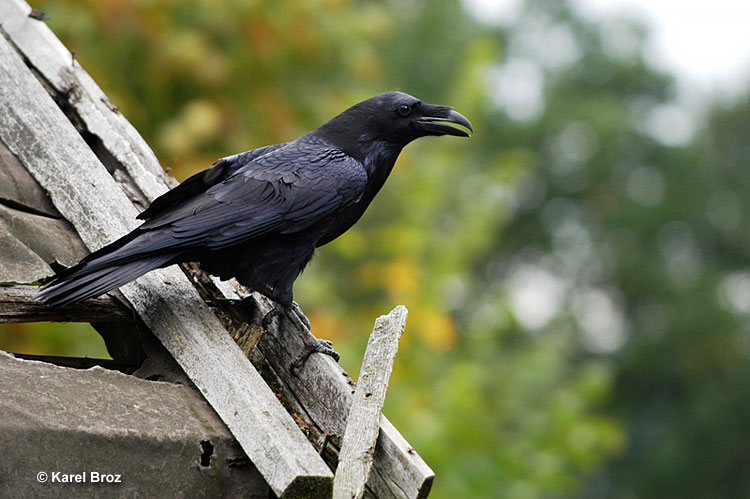
Scientific name: Corvus corax
Length: 24 inches
Weight: 2.6 pounds
Wingspan: 53 inches
Song: “Grauk Grauk Grauk Grauk!”
The Common Raven is a big, black crow-like bird with long, broad wings and a broad, wedge-shaped tail.
Both sexes look alike and have feathers extending onto the top part of their strong, stout beaks.
This bird is often seen in soaring flight or in direct flight where it gives a few strong flaps between glides.
Common Ravens are omnivores that feed on carrion, small animals, nesting birds, and various other food items. They forage by flying above roads and other places and are always on the lookout for feeding opportunities.
This big Corvid makes a big, bulky nest out of sticks and lines the shallow cup with mud, wool, and other items. It builds its nest on a cliff, tree, bridge, or other structure.
The Common Raven lives in wilderness areas from the Arctic to parts of the northeastern USA and the western USA. In some places, it lives in urban areas.
Key Identifications:
- Huge, black, crow-like bird with a strong, stout beak and a wedge-shaped tail.
- An omnivore that feeds on small animals, carrion, and other food items.
- Makes a big bulky stick nest in trees, on cliffs, and on human-made structures.
- Common Ravens are vocal birds. One of their most common calls is a load and croaking, “Grauk Grauk Grauk Grauk!”.
The Common Raven is a large, black, crow-like bird of mountains, forest, tundra, and other wild areas. Some also live near people and, in flight, they can sometimes be mistaken for raptors. However, no hawk species is entirely black with a wedge-shaped tail. The Common Raven can mimic human speech and is one of the most intelligent bird species.
Downy Woodpecker
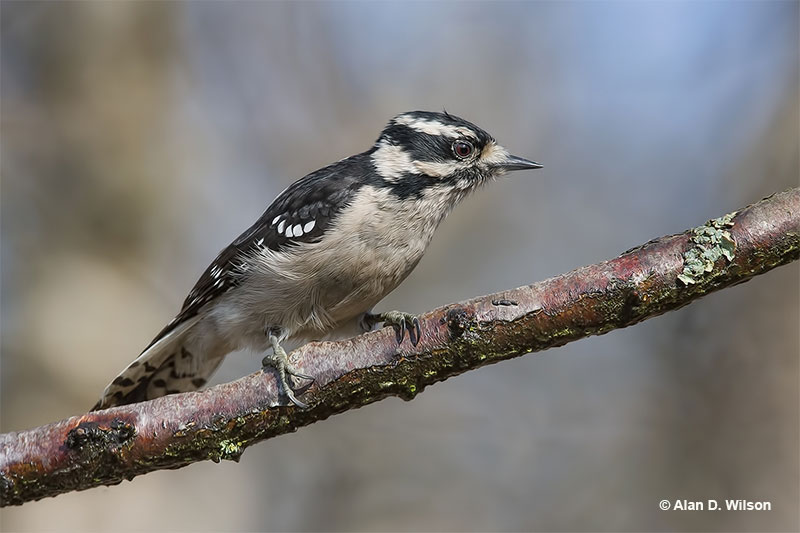
Scientific name: Dryobates pubescens
Length: 6.75 inches
Weight: .95 ounces
Wingspan: 12 inches
Song: “Pik! Ch,ch,ch,ch,ch,ch,ch!”
The Downy Woodpecker is a small black and white woodpecker with a short, black beak. They are patterned black and white above and have white backs and white underparts. Both sexes look alike except that males have a small, bright red patch on the top back part of their head.
Young birds look like adults but have a reddish patch on the top of their head. Downy Woodpeckers also have a few small black marks in their white outer tail feathers, and a small white tuft at the base of their beak.
This woodpecker eats insects, other small creatures, seeds, and small fruits. It pecks into live and dead wood and often forages on smaller branches and twigs. These friendly little woodpeckers are also common feeder birds.
They nest in tree cavities and live in gardens and a wide variety of woodlands. We see Downy Woodpeckers in much of Canada and the USA but not in arid habitats.
Key Identifications:
- Smallest woodpecker in North America. Mostly black and white with a short, black beak.
- Forages on trees, in bushes, and at feeders for insects, seeds, and suet.
- Nests in tree cavities.
- The Downy Woodpecker makes sharp “pik!” calls and also has a trilled call, “Ch,ch,ch,ch,ch,ch,ch!“.
Downy Woodpeckers are the smallest woodpecker species in North America and usually occur in pairs. They can also forage with other small birds and often visit feeders. This species takes advantage of its size to peck into the stems of weeds and other plants too small for larger woodpeckers to perch on.
House Sparrow
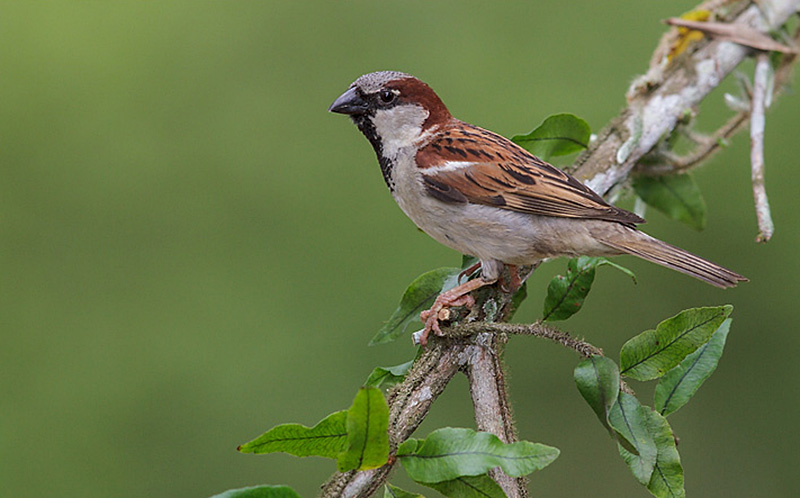
House Sparrow (Passer domesticus) perched on a branch in the Atlantic rainforest of southeast Brazil.
Scientific name: Passer domesticus
Length: 6.25 inches
Weight: .98 ounces
Wingspan: 9.5 inches
Song: “see,chirrup,see,chirrup,see,chirrup”
House Sparrows are small, plump gray and brown birds with conical, finch-like beaks. Males have a gray and rufous head with pale cheeks, and black near their eyes and on their throat.
The rest of their underparts are gray and they have brown, streaked backs with rufous highlights. They also have a white mark in the shoulder of each wing and a grayish rump and tail.
Females are plainer brown and buff, have paler beaks, and buff eyebrows.
House Sparrows feed on seeds, grain, and insects. They are regular visitors to bird feeders and often dominate other smaller species. They also forage on the ground in farmlands, parks, urban areas, and other open situations.
The House Sparrow nests in cavities. When searching for suitable nesting sites, they can kill and remove the eggs and young of smaller species like Eastern Bluebirds.
House Sparrows usually live near people and occur in most of North America, including Colorado.
Key Identifications:
- Brown and gray sparrow with a bold pattern on its head.
- Feeds on seeds, grain, and insects at feeders and on the ground in urban areas and farmlands.
- Nests in tree cavities, including nest boxes.
- This species is vocal and often makes short chirping calls. Its song is a friendly series of chirping sounds, “see,chirrup,see,chirrup,see,chirrup”.
In many places, the House Sparrow is the common urban sparrow. It occurs in pairs and small groups that forage on sidewalks, in parking lots, farm fields, and other familiar places. This species is one of the very few birds that has evolved to live with people and digest the same grains that we eat.
Ring-billed Gull
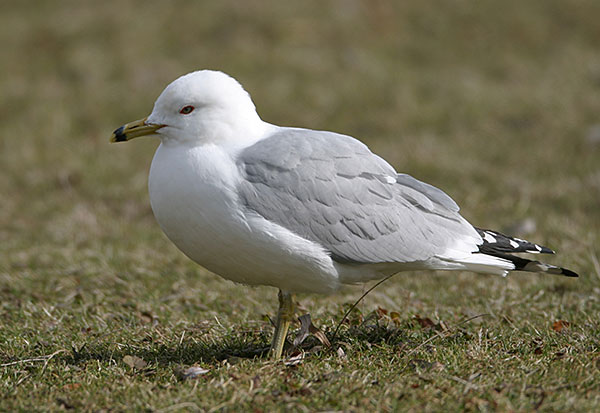
Scientific name: Larus delawarensis
Length: 17.5 inches
Weight: 1.1 pound
Wingspan: 48 inches
Song: “KLEE..KLEEE..kleeya,kleeya,kleeya”
The Ring-billed Gull is a medium-sized pale gray and white gull with a black ring around its yellowish beak. Males and females look the same and have yellowish legs and feet, pale eyes, and black wing tips with a few white spots.
These gulls have direct, fairly quick flight with leisurely wing beats. Young birds have pink and black bills, a white tail with a black tip, and mottled black and gray wings.
Ring-billed Gulls are scavengers and opportunists that feed on carrion, fish, worms, small animals, grain, and other food items. They usually occur in flocks that roam lakes, rivers, urban areas, and other habitats in search of feeding opportunities.
These gulls also gather in farm fields to feed on grain and worms.
The Ring-billed Gull breeds in colonies, often on islands, and makes a shallow stick nest on the ground.
This gull species occurs not only in Colorado, but also in many parts of Canada and the USA south to Central America.
Key Identifications:
- Medium-sized pale gray and white gull with a black ring on its bill and yellow legs and feet. Juveniles have pink and black beaks.
- Forages for fish, carrion, and many other food items in wetlands and open habitats.
- Nests on the ground, in colonies.
- Ring-billed Gulls often call. In flight, they often make a high-pitched “kleea” sound. On the ground, displaying birds make a loud, laughing, “KLEE..KLEEE..kleeya,kleeya,kleeya”.
Ring-billed Gulls are pale gray and white, medium-sized gulls with a black ring around their beaks and yellow legs and feet. They are well adapted to living with people and occur around lakes, rivers, and other wetlands, parking lots, garbage dumps, and other places. This gull species is a bold bird that can snatch bits of food from unguarded picnic tables.
White-crowned Sparrow
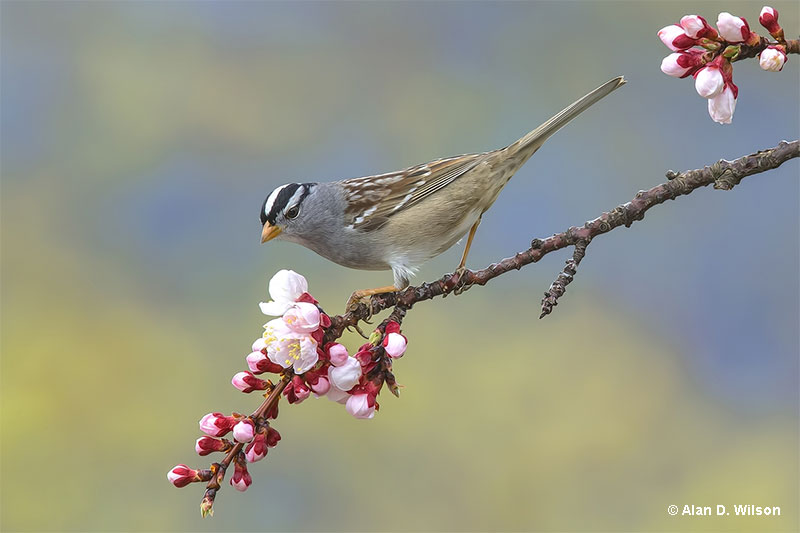
© Alan D. Wilson
Scientific name: Zonotrichia leucophrys
Length: 7 inches
Weight: 1 ounce
Wingspan: 9.5 inches
Song: “tuuur teeteetee zhree zhree zeh”
The White-crowned Sparrow is a thrush-sized sparrow with black and white stripes on its head, and a small, finch-like orange or pinkish beak.
Both sexes look alike and have a gray face, gray underparts with pale brown flanks, streaked brown back, and gray-brown rump. Their rounded wings are mottled brown with two pale wing bars.
In winter, young birds have brown and tan stripes on their head.
The White-crowned Sparrow feeds on insects, seeds, grass, buds, and fruit. It forages by picking food items from the ground and in low vegetation. In winter, this species moves around forest and park-like habitats in flocks.
This sparrow makes a cup nest out of grass, bark strips, and other plant matter and builds it on the ground or in a low bush.
White-crowned Sparrows occur in shrubby habitats in Alaska, Canada, the Rocky Mountains, along the Pacific Coast, and winter in much of the western, central, and eastern USA.
Key Identifications:
- Thrush-sized sparrow with a black and white striped head, gray underparts, orange or pinkish finch-like beak, and two wing bars.
- Eats insects, seeds, and fruit on and near the ground, often in flocks.
- Makes a cup nest on or near the ground.
- Makes a sharp call, “Pick!” and sings a pleasant song, “tuuur teeteetee zhree zhree zeh”.
The White-crowned Sparrow is a fairly large sparrow with black and white stripes on its head. Young birds have brown and tan striped heads and this species occurs in flocks in the winter. Some White-crowned Sparrows are “bilingual” as they learn more than one regional song.
Mountain Chickadee
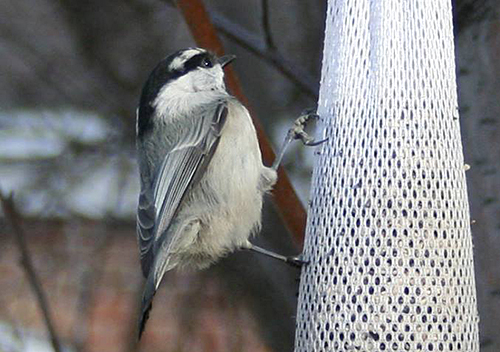
Scientific name: Poecile gambeli
Length: 5.25 inches
Weight: .39 ounces
Wingspan: 8.5 inches
Song: “pifeeee bee bee!”
The Mountain Chickadee is a small, pale, frosty gray bird with a black cap, white eyebrow, and black throat. Both sexes look alike and have small, stout black beaks.
This species mostly feeds on beetles, caterpillars, aphids, other insects, and spiders. It finds food by picking these food items from coniferous twigs and branches. The Mountain Chickadee usually forages in flocks with other chickadees and warblers.
Mountain Chickadees also visit bird feeders at any time of the year and forage for seeds of pinyons and other conifers in the winter.
This small cute bird makes a soft, cup nest of moss, lichen, and animal fur. It builds its nest in a tree cavity, nest box, or in tree roots.
Mountain Chickadees are year-round residents of coniferous forests in western Canada and the western USA. As long as conifers are present, they can also occur riparian zones.
Key Identifications:
- Small frosty gray bird with a black cap, black throat, and white eyebrow.
- Picks insects and spiders from coniferous vegetation, also eats conifer seeds in winter, and at feeders.
- Makes a soft cup nest of moss, lichen and fur in tree cavities or nest boxes.
- Often calls and makes a, “chick a dee dee dee” vocalization and a whistled, pifeeee bee bee”.
The Mountain Chickadee is a frosty gray bird with a black cap, white eyebrow, and black throat. It forages in flocks with other small birds in montane coniferous forests of western North America. When disturbed at its nest, this species makes s snake-like hissing noise.
Great Blue Heron
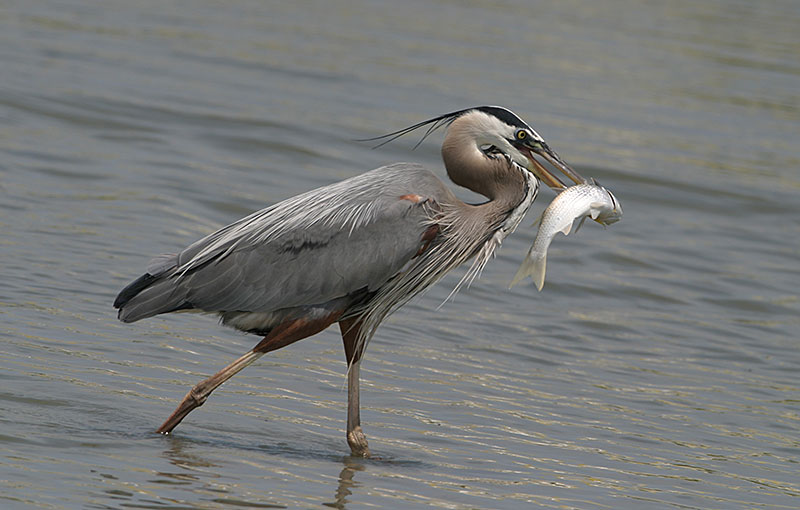
Scientific name: Ardea herodias
Length: 46 inches
Weight: 5.3 pounds
Wingspan: 72 inches
Song: “Grunk! Grunk!”
The Great Blue Heron is a large, gray and pale brown heron with a long neck and legs. It has a strong, yellowish beak, black and white head with a wispy black crest, and rufous thighs.
Both sexes are alike and have pale bellies and black flanks. Juveniles have streaked underparts.
In flight, they make slow, deep flaps with long, broad gray and black wings. In Southern Florida and the Caribbean, Great Blue Herons are all white and sometimes considered a separate species, the “Great White Heron”.
These powerful herons feed on fish and small animals such as rats, snakes, and birds. They wade in and near water, wait, and then quickly catch prey with their sharp beaks.
Great Blue Herons build messy, stick nests and breed in colonies, often in swamps.
We find these impressive birds in and near a wide variety of wetlands in large parts of Canada, the USA, and the Caribbean.
Key Identifications:
- Huge gray and pale brown wading bird with a thick, yellowish beak and a wispy crest. In southern Florida, it is all white but still has a crest and a strong yellowish beak.
- Stalks and preys on fish and small animals.
- Builds messy stick nests and breeds in colonies.
- Great Blue Herons aren’t all that vocal. When taking flight they make a croaking sound, “Grunk! Grunk!“.
The Great Blue Heron occurs on rivers, lakes, and many other wetlands. It stands still for long periods of time while waiting for prey to come within range of its sharp beak but is also, often seen in flight. In some parts of Florida, Great Blue Herons have a gray and brown body and a white neck and head. These birds are known as, “Wurdemann’s Heron”.
Broad-tailed Hummingbird
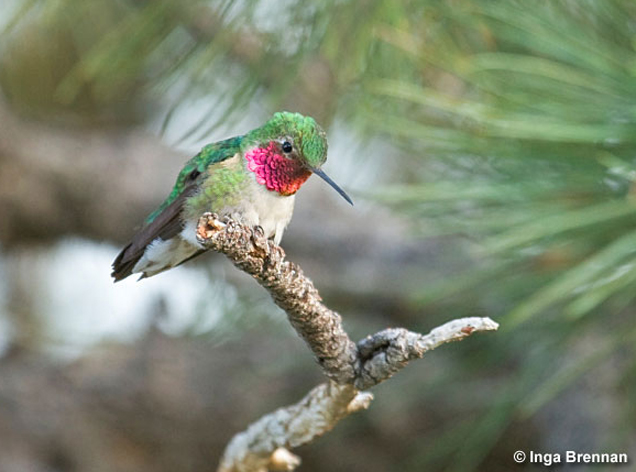
The Broad-tailed Hummingbird is a small bird with a long, needle-like beak, green upperparts, and greenish, white, and buff underparts. Males have a glittering, rose-red or magenta colored throat.
Females have small green spots on their throat, are buffier below, and have a bit of rufous and black and white in their tail.
This hummingbird species feeds on nectar from small flowers and catches tiny insects in flight. It feeds from flowers and catches insects while hovering, and also visits hummingbird feeders.
Broad-tailed Hummingbirds use lichen, moss, and spider webs to make a small cup nest built on a branch over a stream or a branch with some cover overhead.
This species lives in montane meadows with plenty of flowering shrubs and other small plants in the Rocky Mountains of the western USA, Mexico, and northern Guatemala. Birds that breed in the USA migrate to Mexico for the winter.
Key Identifications:
- Small hummingbird but slightly bigger than Rufous and Ruby-throated Hummingbirds. Male has a rose-red throat, female has small green spots on her throat and a bit of rufous in her tail.
- Takes nectar from flowering shrubs and feeds at hummingbird feeders. Also catches tiny insects in flight.
- Makes moss and lichen cup nest on a branch over a stream or on a branch with some cover overhead.
- Makes sputtering calls, “treetretretretreetretretreee!”. The male also makes a buzzing sound with its wings during his diving display.
Broad-tailed Hummingbirds are montane hummingbirds with rose-red throats, some buff on their underparts, and some rufous in their tails. These birds are more or less restricted to the Rocky Mountain region. To survive the cold nights in the high elevation habitats where they occur, Broad-tailed Hummingbirds enter a brief hibernation known as “torpor” where they lower their heart rate and body temperature.
Western Meadowlark
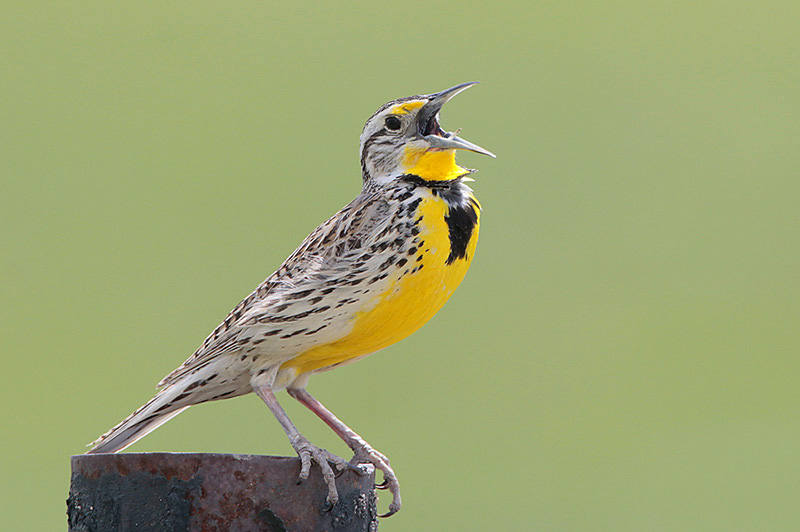
Scientific name: Sturnella neglecta
Length: 9.5 inches
Weight: 3.4 ounces
Wingspan: 14.5 inches
Song: “trip tree tur ripuhdip”
The Western Meadowlark is a chunky, pale brown and yellow bird with a long straight beak. Males and females look alike and have a large black “V”-shaped mark on their bright yellow breast. The rest of their underparts are white with some dark marks on their flanks.
They also have a narrow white stripe down the middle of their dark crown, a long yellow and white eyebrow, and a pale face with a dark line going back from their eyes.
This bird shows white in the tail, especially in flight, and also has a little bit of yellow on the lower part of the face.
Western Meadowlarks forage on the ground in open habitats for insects and seeds.
This species uses grass and other bits of vegetation to make a hidden nest on the ground.
The Western Meadowlark lives in a variety of open habitats in parts of Canada, the central and western USA, and Mexico. They are common birds of Colorado.
Key Identifications:
- Robin-sized, pale brown and yellow rotund bird with a black “V” mark on its breast.
- Forages for insects and seeds on the ground in open habitats.
- Makes a hidden, dome-like nest out of grass and soft vegetation, on the ground.
- This birds has a rattle call, often in flight, and sings a pleasant, melodious whistled song, “trip tree tur ripuhdip”.
The Western Meadowlark is a chunky pale brown and yellow bird with a black “V” mark on its breast. Pairs are conspicuous in wide open habitats of central and western North America. On account of its beautiful song and appearance, this conspicuous bird was chosen to be the official bird for six different states.
Killdeer
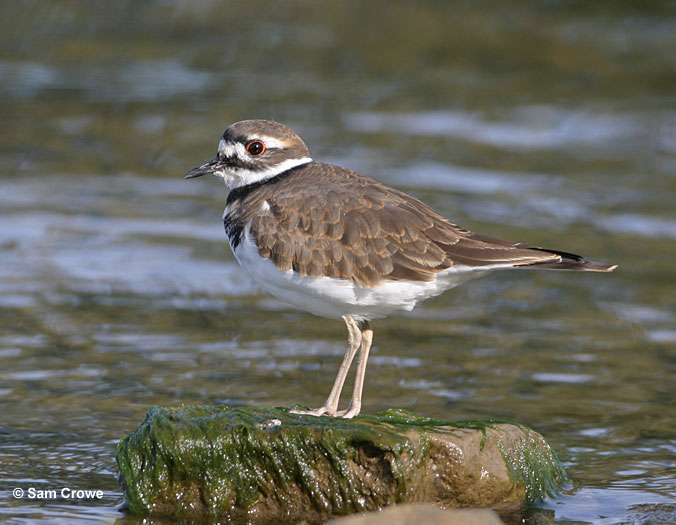
Scientific name: Charadrius vociferus
Length: 10.5 inches
Weight: 3.3 ounces
Wingspan: 24 inches
Song: “tideer, tideer, tideer, tideer”
The Killdeer is a fair-sized, slender plover that is dark brown above and white below. They have two black bands on their breast, a patterned, black, white, and dark brown face, and a longish, orange tail.
Both sexes look alike and also have a slender, black bill, narrow, red-orange eyerings, and long, pale legs. In flight, we can see a white stripe in each of their long, dark wings, and a black tip on their long, wedge-shaped, orange tail.
Killdeers often fly high overhead in fast, direct flight but we usually see them foraging on the ground. They pick insects, other small creatures, and seeds from the edges of wetlands and other, open grassy areas.
This species lays its camouflaged eggs on the ground, in gravel and open fields. When people and pets approach too close, they give loud calls and pretend to have a broken wing.
The Killdeer lives in large parts of Canada, the USA, Mexico and also Colorado.
Key Identifications:
- Fair-sized plover with two black breast bands and a wedge-shaped orange tail with a black tip.
- Picks seeds and small creatures from open ground.
- Lays camouflaged eggs on the ground, in gravel and open fields.
- Very vocal and sounds like it says its name, “tideer, tideer, tideer, tideer”.
The Killdeer is the most common and familiar shorebird in much of its range and occurs in many open habitats. It is the only plover in North America with two black breast bands and has a longish, orange tail with a black tip. To scare cows near their nests, Killdeers fluff themselves to look bigger, raise their tail over their head, and run at the large animal.
Gadwall
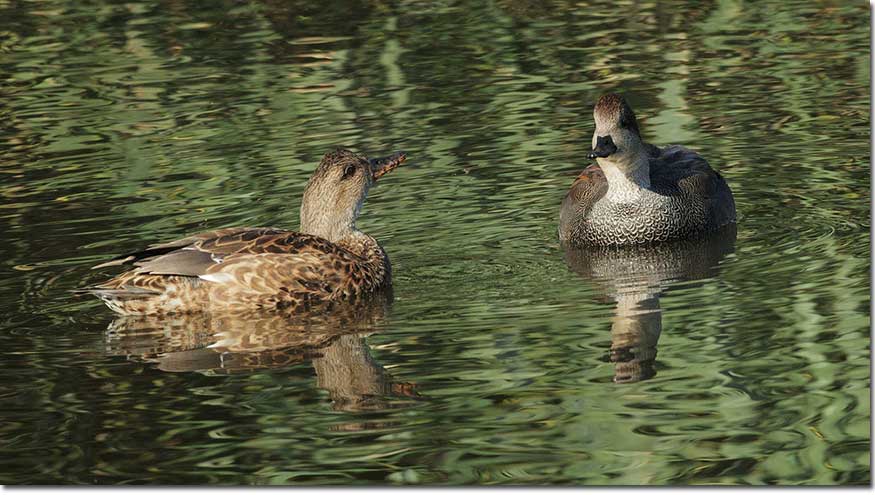
Scientific name: Mareca strepera
Length: 20 inches
Weight: 2 pounds
Wingspan: 33 inches
Song: “reh reh reh reh reh”
The Gadwall is an average-sized duck with a white belly and a small white patch in each wing. The male is gray with some tan on its wings, and has a pale, gray-brown head and black beak.
The male Gadwall also has a black rump and undertail. The female Gadwall is mottled gray-brown and buff with a plain grayish head, and has a gray and orange beak.
Gadwalls forage for seeds and aquatic plants by dipping below the surface and using their beaks to pick up food items. They often occur in flocks of a hundred or so birds.
This duck species nests on the ground in meadows and other areas with tall grass. It makes a shallow scrape hidden in dense vegetation.
The Gadwall breeds in wetlands in southern Alaska, and in western, central, and southern Canada. It also breeds in the western, central, and eastern USA, and winters in wetlands in the western, central, and southern USA.
Key Identifications:
- Gray duck with a black beak, black rump and undertail (the male), or buff and gray-brown with an orange and gray beak. Both sexes have a white belly and small white wing patch.
- Dabbles for aquatic plants and seeds in wetlands.
- Makes a shallow scrape on the ground in meadows and other spots with dense grassy vegetation.
- Makes nasal, rasping quacking calls, “reh reh reh reh reh”.
The Gadwall is a grayish or buff and brown duck with a white belly and a small white wing patch. This species frequents a variety of wetland habitats, often in loose flocks of 100 or so. This duck steals food from coots and other ducks.
Barn Swallow
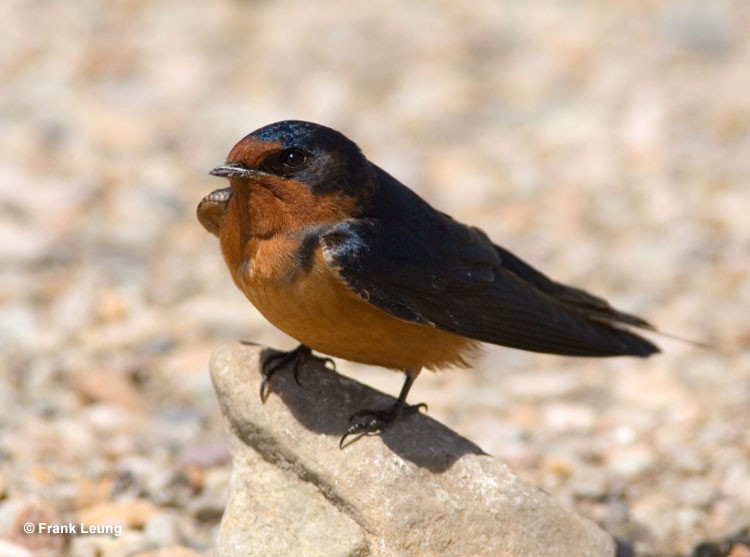
Scientific name: Hirundo rustica
Length: 6.75 inches
Weight: .67 ounces
Wingspan: 15 inches
Song: “chipchipfitfibitchipfibitfwip”
Barn Swallows are small to medium-sized swallows with long forked tails. They are dark, steel-blue above, peach-orange below, and have rich chestnut on the throat and above their bill. It also has some white in its tail.
Males and females look similar but females are paler and have shorter tails. Young birds are like females but their tails are even shorter.
The Barn Swallow is one of the most common birds in Colorado. It has long, pointed wings and fast flight. When flying, they often flap their wings a few times between brief glides.
Barn Swallows live in farming areas, meadows, parks, and other open habitats. They feed on insects as they fly through the air. Although they can fly high overhead, Barn Swallows often swoop low over the ground.
This handsome swallow builds a mud nest on the wall of a barn, bridge, or other structure. Barn Swallows live in large areas of Canada, the USA, Mexico, Europe, and Asia.
Key Identifications:
- Beautiful dark blue and orange swallow with a long, forked tail.
- Forages for insects in flight over fields and other open habitats.
- Constructs a cup nest out of mud in barns and other structures.
- Often makes brief “fwip” calls in flight, and has a long, complex song, “chipchipfitfibitchipfibitfwip”.
The Barn Swallow is a common and easily species in most of its range, and the only swallow with a long, elegant tail. In summer, it is often seen flying low over the ground in open habitats. Barn Swallows are long distance migrants and some fly 5,000 miles, all the way to Argentina!
House Wren
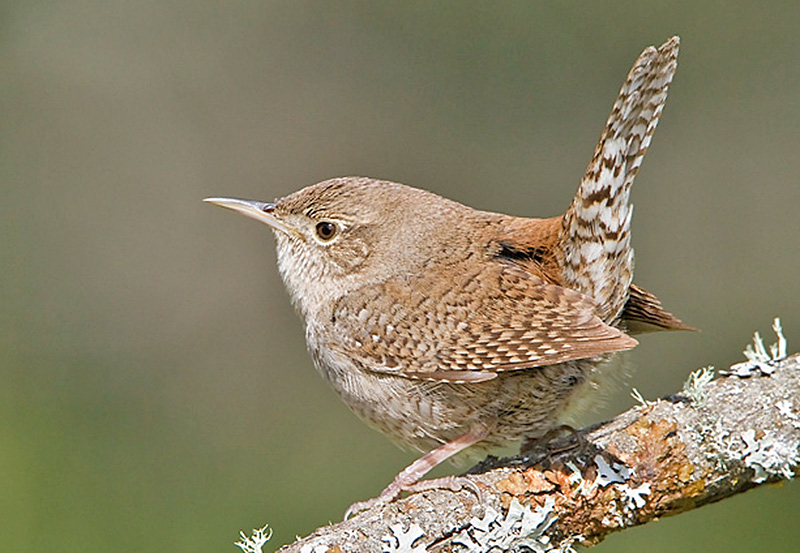
Photograph © Glenn Bartley.
Scientific name: Troglodytes aedon
Length: 4.75 inches
Weight: .39 ounces
Wingspan: 6 inches
Song: “sipsipsip twee tereesupsupsup”
The House Wren is a small plain, grayish-brown bird with a thin, sharp, slightly downcurved beak. Males and females look alike, have pale throats, and dark barring on their wings, tail, and under the tail.
They feed on insects, spiders, and other small creatures on logs, in thickets, and in foliage. These inquisitive little birds search for food in low vegetation, rocks, and around structures on and near the ground.
These wrens also find food in dead leaves and other tangled vegetation, and aren’t shy about picking bugs from windows or briefly entering houses. They often hold their tails cocked up.
The House Wren nests in tree cavities and nest boxes. Inside the cavity, it makes a platform out of sticks and constructs a small cup nest on top.
House Wrens occur alone or in pairs in gardens, forest edge, and open, wooded areas in much of Canada, the USA, and Central and South America.
Key Identifications:
- Small, plain grayish-brown bird with a sharp, slightly decurved beak and a pale throat.
- Forages for insects and other small creatures on and near the ground.
- Nests in tree cavities and nest boxes.
- The House Wren is a vocal bird that often makes short raspy calls. They also frequently sing a bright and bubbly song, “sipsipsip twee tereesupsupsup”.
The House Wren is a small, plain gray and brown bird often seen in gardens, parks, and around houses. Pairs forage on and near the ground, and frequently call and sing. House Wrens sometimes add spider egg sacs to their nests. When the spiders hatch, they help control mites and other small insects inside the nest.
Rock Pigeon
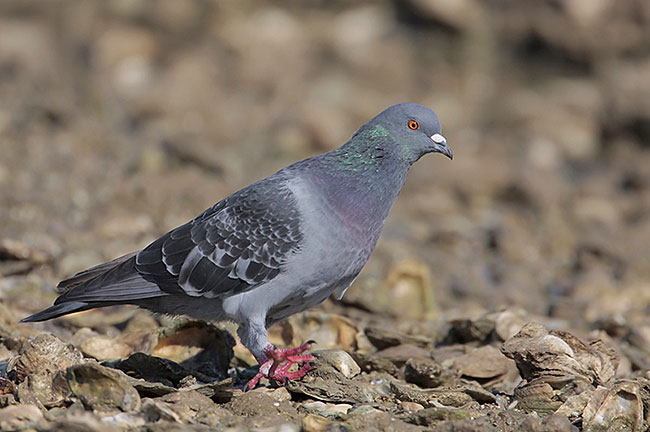
Scientific name: Columba livia
Length: 12.5 inches
Weight: 9 ounces
Wingspan: 28 inches
Song: “tititik grewh”
The Rock Pigeon is the familiar and common “pigeon” of cities, farms, and other urban situations. Although this pigeon can show a variety of plumages, the most frequent one is pale gray with dark gray on the head and neck, and a dark gray tail with a dark tip.
It also has iridescent green on its neck and two black wing bars.
This species has quick and direct flight with rapidly beating wings.
Rock Pigeons usually occur in flocks and large ones can form in farm fields and some urban areas. They pick seeds and grain from the ground, mostly in open areas like farm fields, parks, and city streets.
The Rock Pigeon uses sticks and other stick-like objects to make a shallow nest on covered ledges of buildings and other structures.
Rock Pigeons are completely adapted to living with people and occur in urban and farming areas in most parts of North America.
Key Identifications:
- Familiar gray pigeon with dark tip at the end of its tail and two black wing bars.
- Picks seeds and grain from the ground of streets, fields, and other open habitats.
- Makes messy stick nests on ledges with overhanging structures.
- Makes a gruffy vocalization, “tititik grewh”.
This species is the common and familiar city pigeon. Rock Pigeons are darker than other doves and feed on the ground in farm fields and streets. Truly wild Rock Pigeons are shy and only live on remote cliffs in Europe and Asia.
Common Grackle
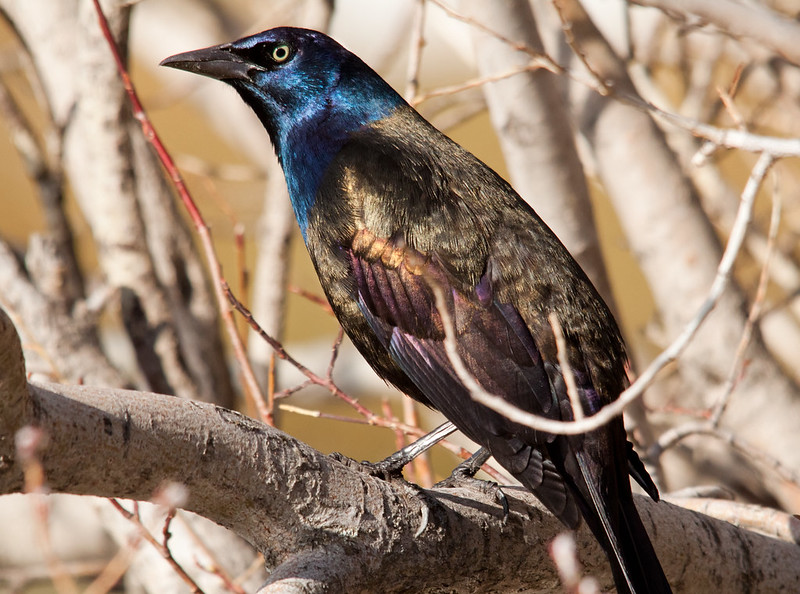
© Shawn McCready
Scientific name: Quiscalus quiscula
Length: 12.5 inches
Weight: 4 ounces
Wingspan: 17 inches
Song: “Sherink!”
The Common Grackle is a jay-sized, glossy black bird with pale eyes and a long, wedge-shaped tail. Depending on lighting, this bird shows metallic purple, blue, green, and bronze highlights.
Males and females look very similar but females have shorter tails and less iridescence. Both sexes also have stout, black beaks, and strong, black legs and feet.
In flight, Common Grackles move up and down as they move through the air. They usually flock together and often forage in farm fields, on lawns, and in other open habitats. These omnivores feed on a variety of items including insects, seeds, grain, small animals, garbage, and the eggs and nestlings of other birds.
Common Grackles build bulky stick nests, usually in conifers in woodlands, parks, near water, and urban areas.
This species can form big flocks in the winter and lives in a variety of semi-open and open habitats in eastern Canada and the eastern USA.
Key Identifications:
- Fairly large, black bird with glossy purple, greenish, bronze, or dark blue highlights. It also has pale eyes and a long, wedge-shaped tail.
- Forages for insects, seeds, and other food on the ground in a variety of open habitats.
- Constructs a bulky cup nest in a conifer.
- Common Grackles are vocal birds. They frequently give raspy, metallic calls, “Sherink!”, and “kek” calls.
The Common Grackle is a common, glossy black bird with pale eyes. It usually occurs in flocks in open and park-like habitats. This species occasionally nests in odd places, including occupied nests of Great Blue Herons and Ospreys!
Double-crested Cormorant
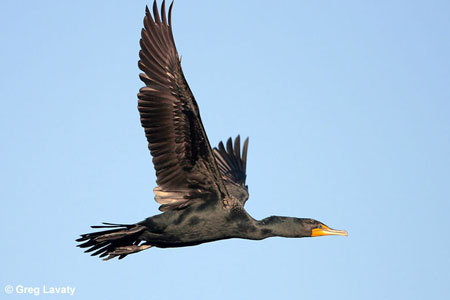
Scientific name: Nannopterum auritum
Length: 33 inches
Weight: 3.7 pounds
Wingspan: 52 inches
Song: “groak”
The Double-crested Cormorant is a big, glossy black bird with a long, thick neck. Males and females look alike and also have a medium-length beak with a sharp, hooked tip, an orange throat patch, and a bit of orange on the face.
Double-crested Cormorants have a short, wispy crest, green eyes, broad tail, and big webbed feet. They use their long wings to flap and glide with direct flight between feeding and roosting areas.
This highly aquatic species feeds on fish. It catches its food by diving, swimming beneath the water and then snatching a fish with its beak. It eats the fish while perched above the water.
The Double-crested Cormorant breeds in colonies and makes a messy stick nest in a tree on an island or above the water. We see this bird in parts of central and southern Canada, in much of the USA, and parts of Mexico and the Caribbean.
Key Identifications:
- Big, nearly goose-sized black bird with a long, thick neck, and a medium-length narrow beak with a small, hooked tip. It also has a rectangular, orange throat patch.
- Forages by floating and then diving beneath the water. Swims underwater to catch fish with its beak.
- Breeds in colonies and constructs a messy stick nest in trees on islands, or over water.
- Double-crested Cormorants aren’t very vocal. They make some low, guttural, pig-like sounds at their breeding colonies, “groak”.
The Double-crested Cormorant is a large, black bird with a long, thick neck and an orange throat patch. It often occurs in flocks that frequent lakes, rivers, and other wetlands. When it comes to fish, this species is not a picky eater; it has been documented eating more than 250 species.
Frequently Asked Questions
How many bird species are native to Colorado?
In total, 519 bird species are native to Colorado. 519 species are on the Colorado bird list.
What is the state bird of Colorado?
Colorado state bird is the Lark Bunting. The bird was chosen to represent the state back in 1931 thanks to Roy Langdon. He wrote many articles to support this cause, including one named “Seventeen Reasons Why the Lark Bunting Should be Colorado’s State Bird”.
What is the most common bird in Colorado?
The most common bird in Colorado is the American Robin. This species is found on more eBird lists in the state than any other species.
What is the largest bird in Colorado?
The largest bird in Colorado is the American White Pelican. This huge species is 62 inches long and has a nine-foot wingspan. Another large bird in Colorado is the Trumpeter Swan. It is 60 inches long, has a wingspan of 80 inches, and weighs 23 pounds.
What is the smallest bird in Colorado?
The smallest bird in Colorado is the Calliope Hummingbird. This tiny bird is just 3.25 inches long.
What is the fastest bird in Colorado?
The fastest bird in Colorado is the Peregrine Falcon. This raptor also the fastest bird on the planet. When diving after prey, it can attain speeds of more than 200 miles per hour.


